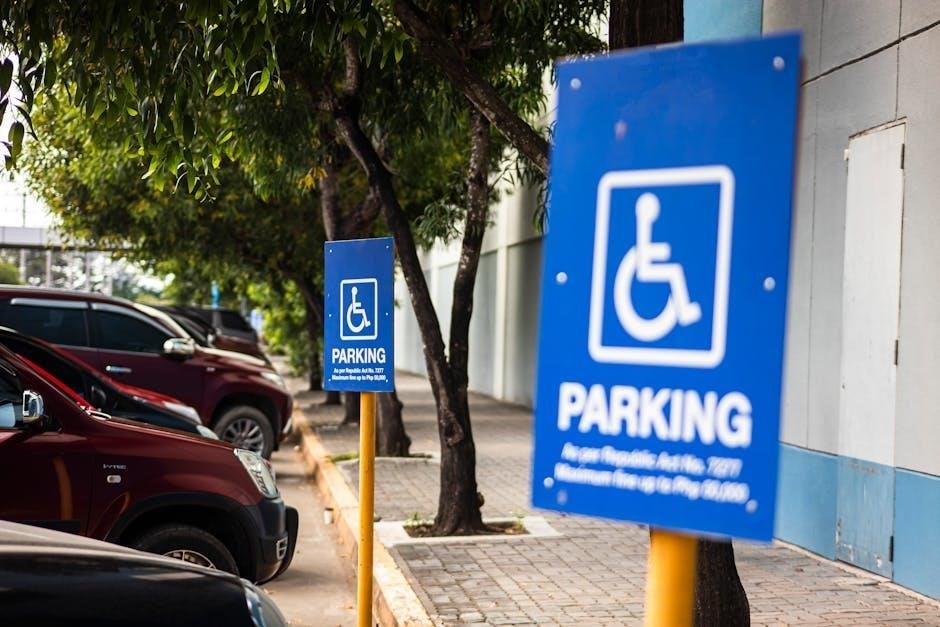
disability visibility pdf
Disability Visibility is a groundbreaking anthology edited by Alice Wong, featuring essays by disabled individuals, marking the 30th anniversary of the Americans with Disabilities Act (ADA). It highlights the importance of representation, amplifying diverse voices and challenging societal stereotypes, while emphasizing the urgent need for inclusion in media and culture;
1.1 Definition and Importance of Disability Visibility
Disability Visibility refers to the representation and recognition of disabled individuals in society, emphasizing their contributions and experiences. It challenges stereotypes and promotes inclusion by amplifying diverse voices. The anthology, edited by Alice Wong, highlights the importance of visibility to foster understanding and equality, ensuring disabled people are seen and valued in all aspects of life, culture, and media.
1.2 Historical Context and the Americans with Disabilities Act (ADA)
The Americans with Disabilities Act (ADA), signed into law in 1990, marked a pivotal moment in disability rights, prohibiting discrimination and ensuring equal opportunities. However, despite this landmark legislation, disabled individuals remain underrepresented in media and culture. The anthology Disability Visibility emerges during the ADA’s 30th anniversary, highlighting the ongoing struggle for inclusion and the importance of amplifying diverse voices to challenge societal barriers and promote equity.

The Anthology: An Overview
Disability Visibility is a collection of essays by disabled individuals, edited by Alice Wong, released during the ADA’s 30th anniversary, emphasizing diverse experiences and advocacy.
2.1 Description of the Book and Its Purpose
Disability Visibility is a collection of essays by disabled individuals, edited by Alice Wong, marking the 30th anniversary of the ADA. The book aims to amplify underrepresented voices, challenging stereotypes and promoting inclusion. Contributors share personal stories, highlighting diverse experiences and the societal barriers they face. The anthology seeks to educate and inspire, fostering empathy and understanding while advocating for disability justice and equality.
2.2 Key Contributors and Their Stories
Alice Wong, a prominent disability activist, edited Disability Visibility, which features essays from a diverse range of contributors. These writers share personal narratives about living with disabilities, highlighting experiences often overlooked in mainstream media. Their stories explore themes of identity, resilience, and societal barriers, offering insights into the complexities of disability. The anthology includes voices from various backgrounds, ensuring a rich tapestry of perspectives that challenge stereotypes and inspire change.

Key Themes and Messages in Disability Visibility
The anthology explores themes of representation, identity, and resilience, challenging stereotypes and advocating for inclusion, accessibility, and a shift in societal perceptions of disability.
3.1 The Struggle for Representation in Media and Culture
Disability Visibility addresses the systemic exclusion of disabled individuals from media and culture, highlighting the scarcity of authentic representation. The anthology challenges stereotypes and invisibility, emphasizing the need for diverse narratives. By amplifying first-person stories, it underscores the importance of accurate portrayal and inclusion, urging a cultural shift to recognize disability as a natural part of human diversity and experience.
3.2 Invisible Disabilities and Their Impact

Invisible disabilities, such as chronic illnesses or mental health conditions, are often overlooked due to their non-physical nature. The anthology sheds light on these experiences, highlighting the unique challenges of living with conditions that are not immediately apparent. Contributors share how societal misunderstandings and lack of accommodations exacerbate their struggles, emphasizing the need for greater awareness and empathy. These stories underscore the importance of recognizing and supporting all forms of disability, visible or not.

The Disability Visibility Project
Founded by Alice Wong, the Disability Visibility Project amplifies disabled voices, creating an inclusive online space for sharing stories, art, and culture, fostering connection and empowerment.
4.1 Founding and Mission of the Project
The Disability Visibility Project, founded by Alice Wong in 2014, aims to amplify disabled voices and promote inclusivity. It challenges stereotypes by sharing diverse stories, art, and experiences, fostering a culture of acceptance and empowerment. The project creates an online space for disabled individuals to express themselves authentically, ensuring their narratives are central to societal conversations about disability and justice.
4.2 The Role of Alice Wong as an Activist and Editor
Alice Wong, a prominent disabled activist, editor, and founder of the Disability Visibility Project, has revolutionized disability advocacy. Through her work, she challenges systemic ableism and amplifies marginalized voices. As editor of Disability Visibility, she curates powerful first-person narratives, reshaping cultural perceptions. Her activism extends beyond literature; she engages in policy advocacy and public speaking, advocating for disability justice and inclusive representation in all areas of society, inspiring significant cultural shifts toward equity and accessibility.

The Impact of Disability Visibility on Modern Society
Disability Visibility challenges stereotypes and promotes inclusion, inspiring a cultural shift by amplifying diverse voices and fostering empathy, thereby transforming media representation and societal attitudes toward disability.
5.1 Changing Perceptions of Disability in Media
Disability Visibility challenges stereotypes by showcasing authentic portrayals of disability, fostering a shift from marginalization to inclusion. By amplifying diverse voices, it demands accurate representation, breaking down stigmas and redefining how disability is perceived in media, promoting inclusivity and authenticity.
5.2 The Cultural Shift Toward Inclusion and Accessibility
The anthology Disability Visibility catalyzes a cultural shift by centering disabled voices, challenging stereotypes, and advocating for accessibility. By amplifying diverse perspectives, it humanizes disabled individuals, fostering empathy and understanding. This shift encourages broader societal changes, such as inclusive policies and accessible environments, promoting equity and representation. The Disability Visibility Project plays a pivotal role in this movement, inspiring a more inclusive and compassionate culture.

Personal Stories and Essays in the Anthology
The anthology features diverse essays by disabled individuals, offering personal insights into their lives, challenges, and resilience, highlighting the importance of authentic storytelling and representation.
6.1 Diverse Perspectives and Experiences
The anthology showcases a wide range of voices, reflecting the varied experiences of individuals with disabilities. Contributors share stories about navigating societal barriers, personal triumphs, and the complexities of identity. These narratives highlight the diversity within the disability community, emphasizing that no two experiences are the same. By amplifying these diverse perspectives, the anthology challenges stereotypes and fosters a deeper understanding of disability as a multifaceted aspect of human life.
6.2 The Power of First-Person Narratives
First-person narratives in Disability Visibility offer profound authenticity, allowing readers to connect deeply with the lived experiences of disabled individuals. These stories humanize disability, challenging stereotypes and fostering empathy. By centering disabled voices, the anthology amplifies their agency and resilience. The personal essays not only educate but also inspire, showcasing the unique perspectives often omitted from mainstream discourse. This approach creates a powerful platform for self-expression and advocacy, driving social change and promoting inclusivity.

The Role of Education and Awareness
Education is crucial in fostering understanding and inclusion, as highlighted in Disability Visibility. The anthology educates readers about diverse disabled experiences, advocating for social justice and equality.
7.1 The Importance of Disability Education in Schools
Integrating disability education in schools is vital for fostering inclusivity and understanding. It challenges stereotypes, promotes empathy, and equips students to engage with disabled peers. By sharing diverse experiences, it encourages social justice and prepares future generations to value all abilities, creating a more inclusive society.
7.2 The Anthology as a Tool for Social Justice
Disability Visibility serves as a powerful tool for social justice by amplifying marginalized voices. Through personal essays, it challenges societal perceptions and advocates for systemic change. The anthology educates readers on disability issues, fostering empathy and understanding. By centering disabled individuals’ experiences, it promotes equity and inclusion, inspiring readers to actively support disability justice and create a more inclusive world.

The Future of Disability Representation
The future of disability representation lies in amplifying diverse voices, challenging stereotypes, and fostering inclusivity. Advocacy efforts and media initiatives will drive progress, ensuring equitable opportunities for all.
8.1 Current Trends in Disability Advocacy
Current trends in disability advocacy emphasize intersectionality, inclusivity, and amplifying marginalized voices. Alice Wong’s work highlights the importance of centering disabled individuals in storytelling. Social media and digital platforms are increasingly used to raise awareness and challenge stereotypes. The rise of disability-led organizations and initiatives underscores a shift toward authentic representation. Advocacy now focuses on policy changes, cultural shifts, and community building, ensuring that disability justice is integrated into broader social justice movements, fostering a more equitable future for all.
8.2 The Vision of Alice Wong for Disability Justice
Alice Wong envisions a future where disability justice is central to societal equity. She advocates for systemic change, amplifying marginalized voices and challenging ableism. Wong emphasizes the power of storytelling to dismantle stereotypes and foster inclusion. Her work promotes intersectional approaches, ensuring disabled individuals are central to decision-making. By creating platforms for shared experiences, Wong aims to build a world where disability is celebrated, and accessibility is a fundamental right, empowering communities to thrive authentically.
Disability Visibility, edited by Alice Wong, challenges stereotypes and promotes inclusion, offering a powerful anthology that amplifies disabled voices, fostering cultural change and accessibility for all.
9.1 Summary of Key Points
Disability Visibility is a pivotal anthology edited by Alice Wong, amplifying diverse voices of disabled individuals. It highlights the lack of representation in media and culture, emphasizing the importance of visibility and inclusion. The collection challenges stereotypes and advocates for disability justice, marking the 30th anniversary of the ADA. Through personal essays, it underscores the need for education and awareness, promoting a cultural shift toward accessibility and equity for all.
9.2 The Lasting Legacy of Disability Visibility
Disability Visibility has left an indelible mark on contemporary discourse, challenging stereotypes and amplifying diverse voices. By sharing personal stories, it has reshaped media representation and inspired advocacy. The anthology, edited by Alice Wong, has become a cornerstone for disability justice, fostering inclusion and accessibility. Its impact extends beyond literature, influencing cultural perceptions and paving the way for future generations to embrace disability as a natural part of human experience, ensuring a lasting legacy of empowerment and equality.